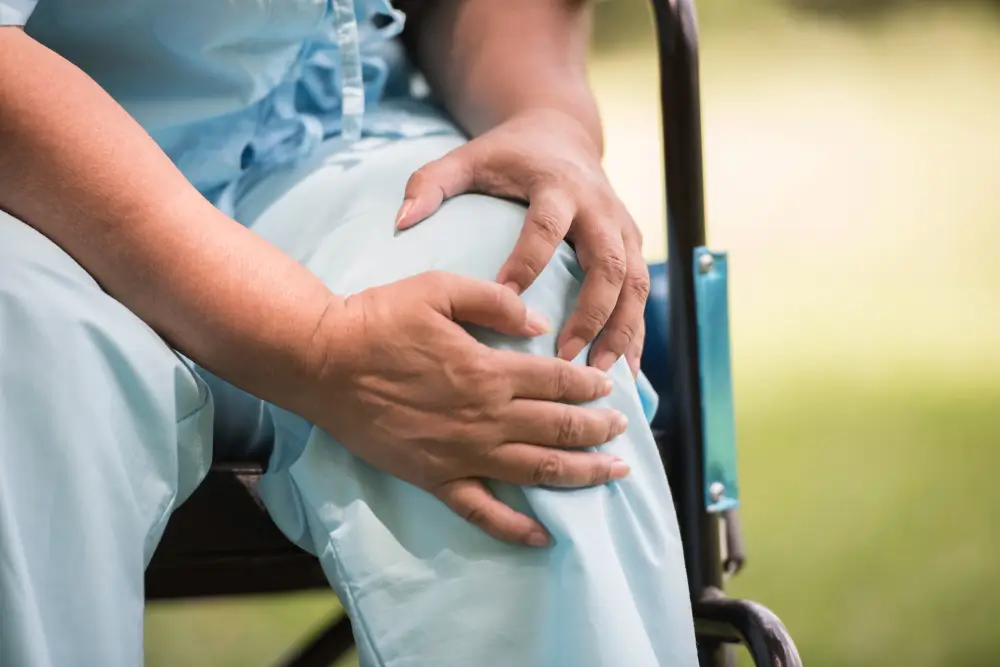How Do I Stop Muscle Spasms After Knee Replacement Surgery?
They told you recovery would take time—but no one mentioned the sudden, jarring muscle spasms that strike without warning after knee replacement surgery. What causes them? And more importantly, how can you make them stop? The answer isn’t as straightforward as you might think—and what you discover could change the way you approach your recovery entirely.
Struggling with muscle spasms? Manage knee pain, click here.

Immediate Ways to Relieve Muscle Spasms
Muscle discomfort after knee replacement surgery is common. When that discomfort turns into sudden, painful spasms, it can seriously disrupt recovery. Several immediate methods can help reduce these spasms safely and effectively, as long as they’re used under proper medical guidance.
- Muscle relaxants: Doctors may prescribe medications that help reduce spasms. These work on the nervous system to calm involuntary muscle contractions.
- Heat therapy: Applying a warm compress to the knee for 15 to 20 minutes can reduce pain and muscle stiffness. Heat has a natural relaxing effect on muscles.
- Gentle stretching and exercises: Light stretches and exercises, like ankle pumps, help improve circulation, reduce stiffness, and ease spasms. These should be done only with your physical therapist’s approval.
- Therapeutic massage: Soft massage around the knee and nearby muscles helps release tension and improve circulation.
- Medication and wound care: Take prescribed medications, including pain relievers or anti-inflammatories, as directed. This helps control pain and inflammation, both of which can lead to muscle spasms.
- Controlled movement: Start moving the knee slowly with professional guidance. Avoid high-impact activities and stay within your comfort range.
- Rest and elevation: Resting and keeping the operated leg elevated helps reduce swelling and can ease spasms. Using cushions for support can make a big difference.
- Sleeping positions: Sleeping on your side with the operated leg straight or supported by a pillow helps maintain good alignment and reduces tension around the knee.
Managing muscle spasms quickly after knee surgery supports a smoother recovery. Using these methods with professional guidance can make a real difference during rehabilitation.
Talk to your doctor or physical therapist before trying any of these options to make sure they’re right for your recovery stage.
Medications and Supplements That May Help
After knee replacement surgery, muscle spasms can become a frequent issue that disrupts rest, movement, and overall recovery.
To manage them effectively, there are several medication and supplement options that help reduce spasms and ease pain. Each case is different, and treatment should be overseen by a healthcare provider who can recommend the best combination based on your needs.
| Type | Examples | Primary Function |
| Non-opioid analgesics | Acetaminophen, Ibuprofen | Relieve pain and reduce inflammation |
| Anticonvulsants | Gabapentin, Pregabalin | Target nerve-related pain |
| Opioids | Oxycodone, Tramadol, Fentanyl | Manage severe pain (used carefully and in moderation) |
| Local anesthetics | Lidocaine, Bupivacaine | Numb the affected area |
| NSAIDs | Naproxen, Celecoxib, Ketorolac | Reduce postoperative inflammation |
| Other analgesics | Ketamine | Used as part of a multimodal pain approach |
| Supplements | Glucosamine, Omega-3 | Support joint function and reduce inflammation |
Managing spasms after knee surgery often involves a combination of medications and supplements. What matters most is following a plan tailored to your specific recovery and how your body responds.
Long-Term Prevention and Recovery Tips
Recovery doesn’t end after leaving the hospital. In fact, most progress happens at home through consistency, patience, and a well-structured routine.
Preventing complications like muscle spasms and supporting full recovery means committing to ongoing care. The following tips can help:
| Area | Recommendations |
| Exercise | Flexion, extension, quad and glute exercises, assisted walking |
| Wound care | Clean daily, avoid soaking, apply ice as needed |
| Pain and inflammation | Take medications as prescribed, use ice regularly |
| Daily activities | Don’t force the knee, avoid lifting, adjust your home space |
| Maintenance | Maintain a healthy weight, avoid impact, stay active |
Staying consistent is key. Move at your own pace, listen to your body, and follow your medical team’s recommendations. Recovery isn’t about going fast—it’s about going steadily.
When Should You Be Concerned?
Muscle spasms are common during recovery after a knee replacement, but you need to pay attention to how severe and frequent they are, along with any other symptoms. If they’re mild and go away quickly, they’re likely part of the healing process.
Watch out for spasms that are intense, ongoing, or interfere with rest and mobility. Other signs like increasing pain, swelling, redness around the wound, fever, or trouble moving the knee could point to something more serious.
Getting to the root of the spasms early helps prevent complications and supports a safer recovery. Don’t ignore what your body is telling you. Acting early can make all the difference.
Sources:
- Scranton Jr, P. E. (2001). Management of knee pain and stiffness after total knee arthroplasty. The Journal of arthroplasty, 16(4), 428-435.
- Price, A. J., Alvand, A., Troelsen, A., Katz, J. N., Hooper, G., Gray, A., … & Beard, D. (2018). Knee replacement. The Lancet, 392(10158), 1672-1682.